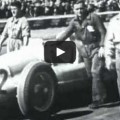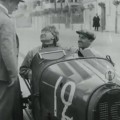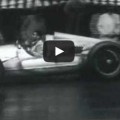The 1937 Tripoli Grand Prix
The Tripoli Grand Prix was a motor racing event first held in 1925 on a racing circuit outside Tripoli, the capital of what was then Italian Tripolitania. Motor racing was an extremely popular sport in Italy and the colony was seeking methods to raise capital and promote tourism — tourists who, it was hoped, would then decide to settle in Tripolitania. But despite the support of the colony’s extremely enthusiastic governor, Emilio de Bono, and some initial success, the events failed financially. Only personal intervention by de Bono kept the 1929 event from being cancelled, and 1930 was marred by a spartan field, little public interest, and the death of Gastone Brilli-Peri in an accident[1]. Initial enthusiasm and sponsorship had retreated, the fallout from Brilli-Peri’s accident meant a 1931 running was impossible, and the dream of a successful Tripoli Grand Prix might have ended there and then.
But the president of Tripoli’s auto club, Edigio Sforzini, was resilient. He decided to organize another Grand Prix, this time on a purpose built European style racing circuit. Sufficient capital was raised from the Italian government’s funding of a fair promoting the colony so as to make the venture possible, and upon the circuit’s completion the Grand Prix was scheduled for the spring of 1933.[1]
This new Mellaha Lake track was a 13.140 kilometer (8.165 mi) long affair situated in a salt basin between Tripoli, Suq al Jum’ah (also known as Suk el Giuma or Sugh el Giumaa (سوق الجمعة)) and Tajura. The track’s most distinctive landmark was a brilliant white concrete tower situated across from a large frontstretch grandstand that could hold up to ten thousand people[2]. Mellaha Lake was equipped with starting lights and a photo-electric timing system[1], both innovations, and the additional amenities rivaled the best that continental European circuits had to offer.
With Italy exerting further control over its North African holdings, including the appointment of Italo Balbo as Governor-General and the joining of Italian Cyrenaica and Italian Tripolitania into a single colony, Libya, the event gained even more spectacle. The participants were treated like royalty, staying in luxury at the Hotel Uaddan with its casino and dinner theater and being entertained by Balbo at his palace. All this led Dick Seaman to describe Mellaha Lake as the “ascot of motor racing circuits”[2], and coupled with its substantial total prize, it is easy to see why the Tripoli Grand Prix became such a popular date on the calendar.
From 1933 to 1938, the Grand Prix was run to the Formula Libre standard, meaning that no weight or engine restrictions were enforced on what was then the fastest track in the world. By 1939, the Italians had tired of Germany’s dominance and they turned it into a Voiturette race for smaller, 1500cc cars, but they were foiled when a specially-built Mercedes driven by Hermann Lang won[3]. In 1940, with only the factory Alfa Romeo and Maserati teams plus independents in attendance, Giuseppe Farina took his only major pre-war victory[4]. It was a phyrric and irrelevant result, and the Tripoli Grand Prix was never held again.



